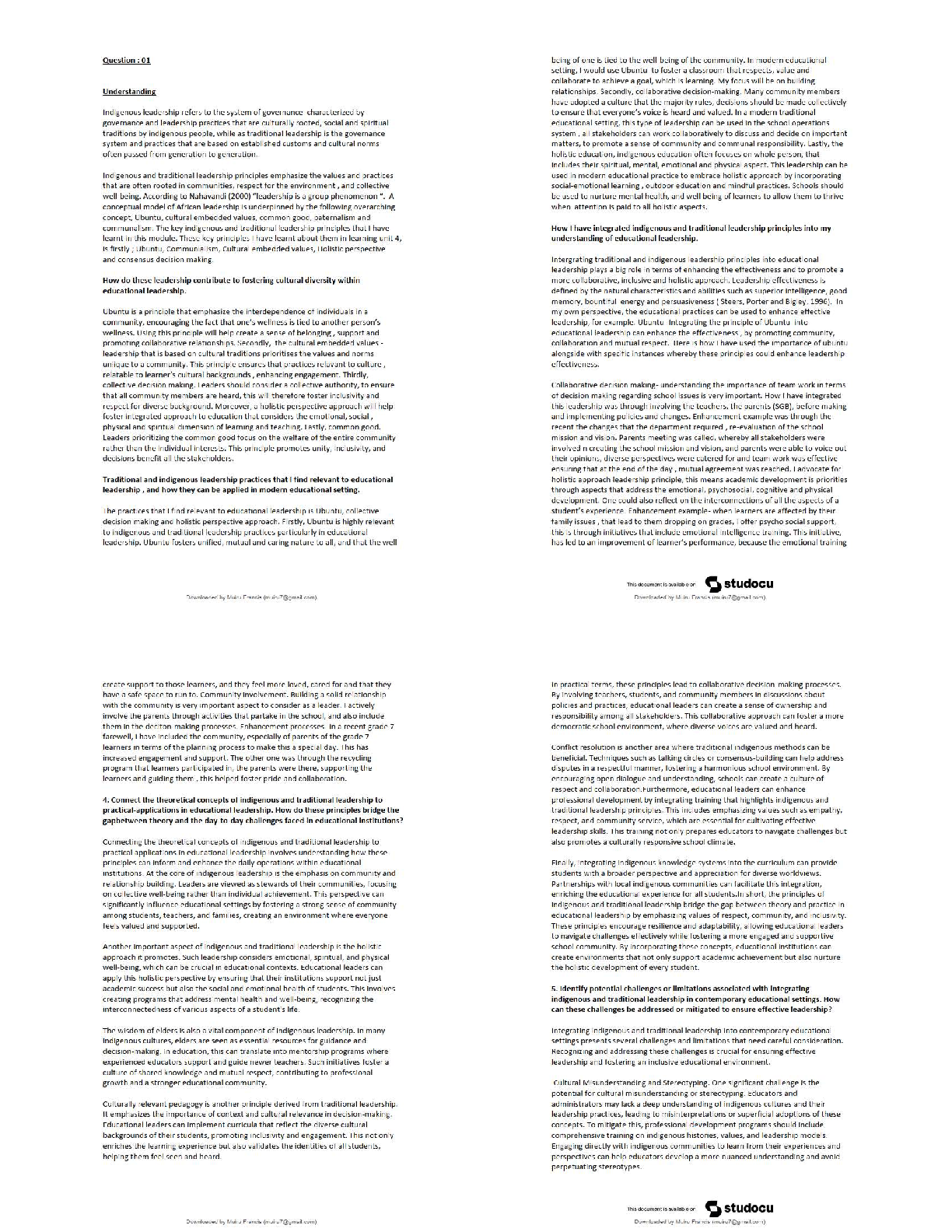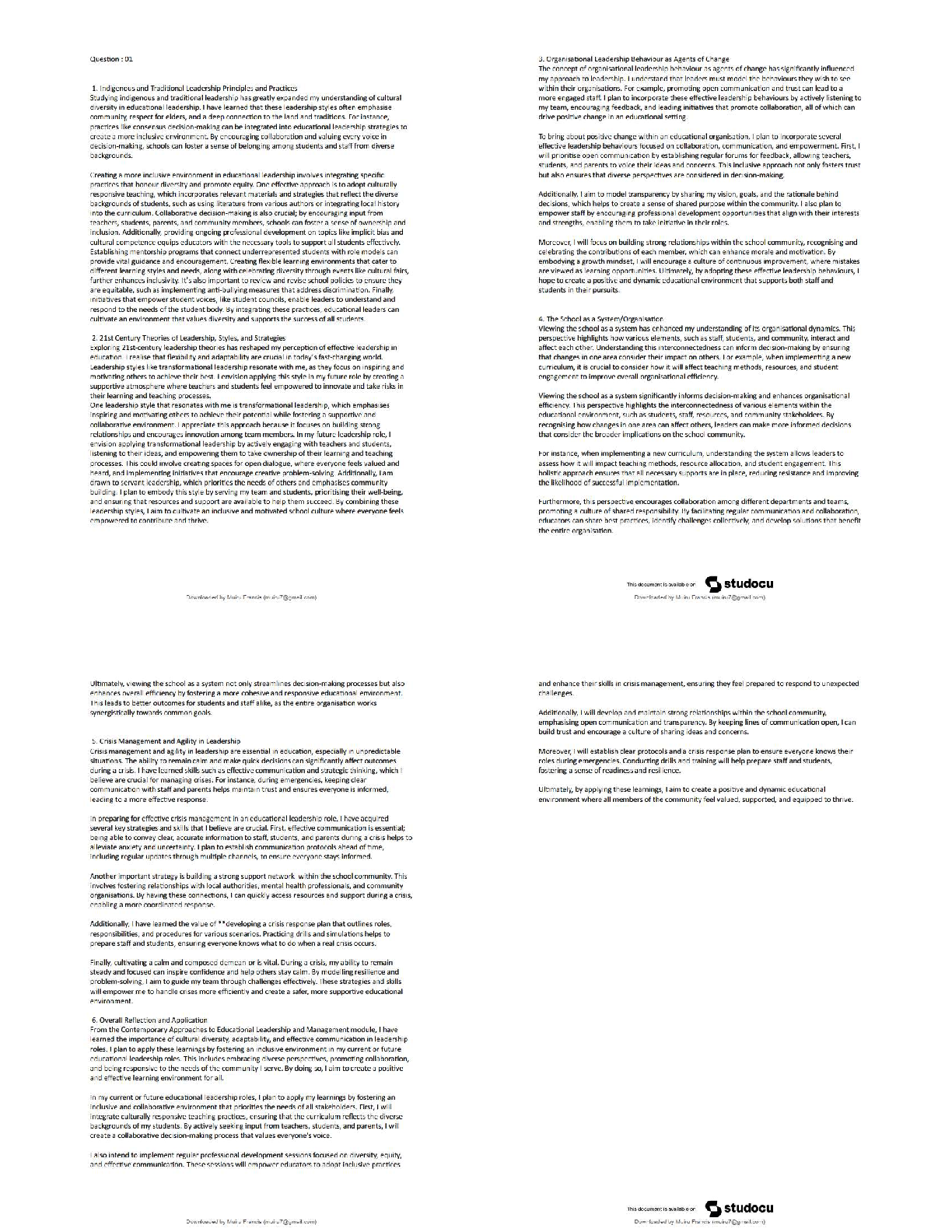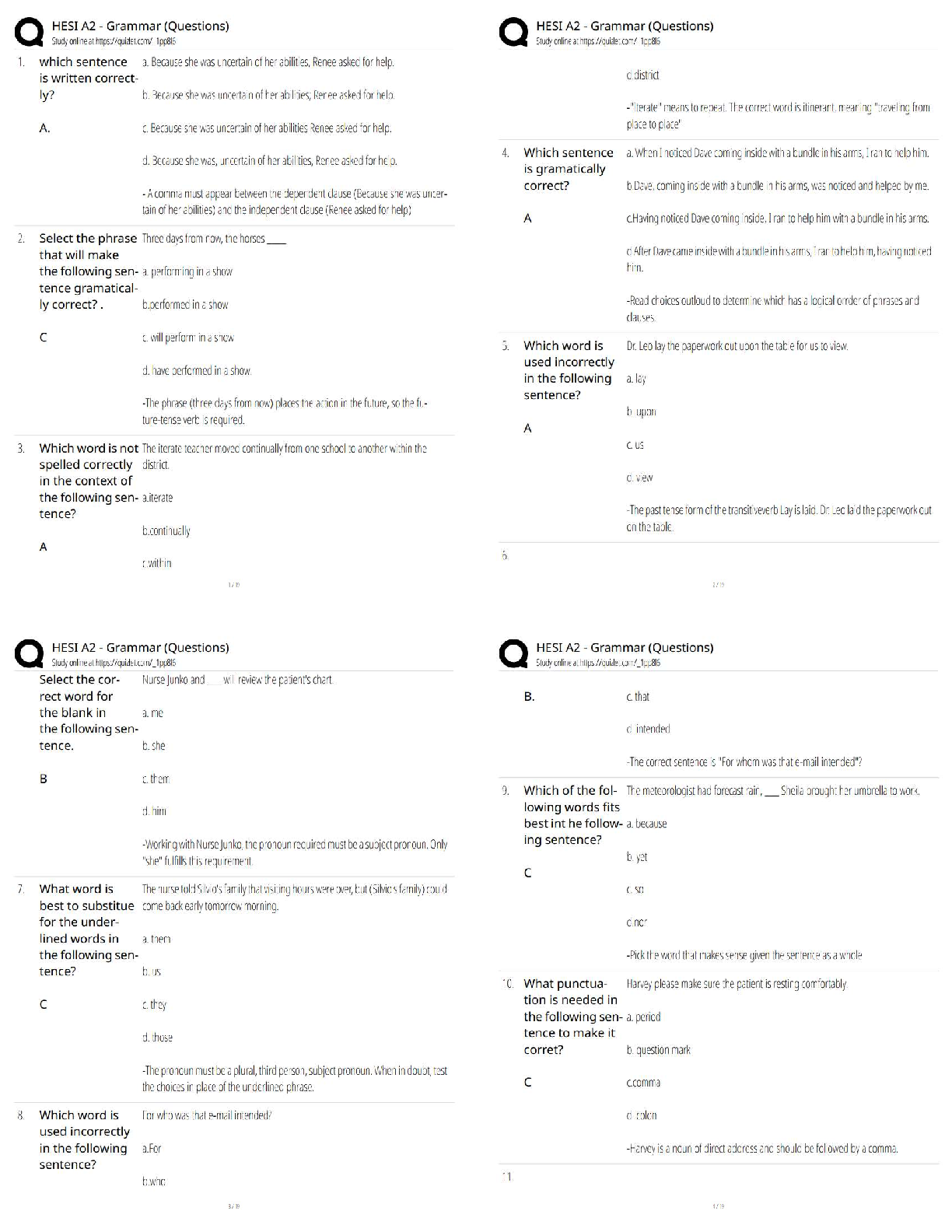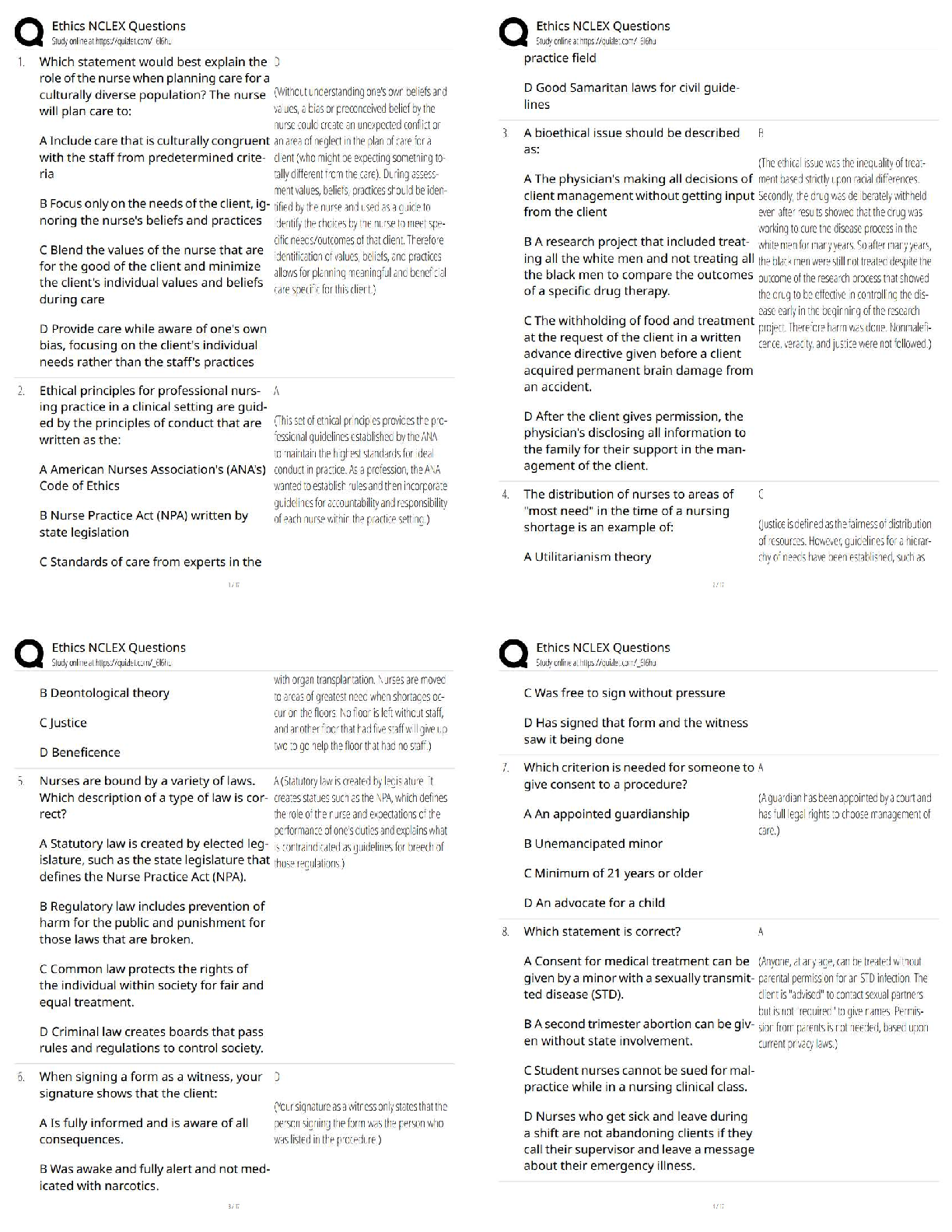NR 601 Week 6 TD 2.docx
Document Content and Description Below
NR 601 Week 6 TD 2.docx
experience urologic concerns with aging. This week's presentations and readings covered urologic concerns and common problems.
Utilize the national guidelines and scholarly r
...
eferences to develop your responses.
Urinary Incontinence
Men and women can both get UTIs. What factors contribute to the development of a UTI in men versus women? Include risk factors.
Men= BPH, kidney stone, urinary retention, self catheterization, cauterization in the hospital, Women= anatomy, poor hygiene, In which sex is a UIT more concerning and why? Men are more concerning BPH
As a provider it is essential for you to know to interpret DRE findings and what your next step should be. The American Urology Association has specific recommendations based on age. Be sure you know these because the guidelines will guide your patient counseling and treatment plan.
What does the AUA state about drawing PSA levels? 4K score If you do decide to draw a level what specific counseling should you
include in your education today? Anal sex and ejaculation Urinary tract infections
It is important to know when to treat a UTI and when not to treat. Is there a particular situation where you would not treat a UTI?
This study source was downloaded by 100000830034489 from CourseHero.com on 08-30-2021 01:35:57 GMT -05:00 https://www.coursehero.com/file/35716661/NR-601-Week-6-TD-2docx/
This study resource wasUrinary Incontinence
What factors contribute to the development of a UTI in men versus women?
Cystitis, which is the most commonly seen lower urinary tract infect
(UTI), and pyelonephritis, the most commonly seen upper UTI (Uphold &
Virginia Graham, 2013). For women, the main cause of a UTI is usually
related to bacteria that enter the urethra (Uphold & Virginia Graham, 2013).
The urethra is shorter in women than compared to men plus it is closer to the
perirectal area, making women more prone to infections (Uphold & Virginia
Graham, 2013). Other risk factors for women include using tampons, if
they’re postmenopausal, increased sexual activity, and pregnancy (Uphold &
Virginia Graham, 2013).
For men, it is uncommon for them to develop cystitis and
pyelonephritis because their urethra is longer but it does happen (Uphold &
Virginia Graham, 2013). In younger men, it is believed that a UTI can occur
because of subclinical prostatitis or endogenous bacteria without an
underlying cause (Uphold & Virginia Graham, 2013). In older men (over
50), UTI’s are generally related to structure abnormalities such as BPH,
obstruction such as kidney stones or urethral strictures, or retention issues
such as with a neurogenic bladder (Uphold & Virginia Graham, 2013). Other
risk factors include lack of circumcision, rectal intercourse, HIV infections
with low CD4 and T-lymphocyte counts, and intercourse with a female who
has vaginal colonization of uropathogens (Uphold & Virginia Graham,
2013).
In which sex is a UTI more concerning and why?
In general, men are more concerning when it comes to UTIs because
their symptoms are generally nonspecific and therefore can go left untreated
(Brusch, 2017).
BPH
What does the AUA state about drawing PSA levels?
This study source was downloaded by 100000830034489 from CourseHero.com on 08-30-2021 01:35:57 GMT -05:00
https://www.coursehero.com/file/35716661/NR-601-Week-6-TD-2docx/
This study resource was
shared via CourseHero.comAccording to AUA guidelines, men less than 40 years old do not need
to be screened and men between 40 to 54 years old do not need to be
screened unless they have a strong family history of prostate cancer or they
are African American (AUA, 2015). For men who are between 55 to 69
years old, the AUA suggests screening based on the man’s preference and
values; it suggests having the patient weigh the benefits against the cons
before proceeding (AUA, 2015). For this age group, if a PSA is desired,
screening regimens can be tailored based on the baseline PSA results
(AUA, 2015). Lastly, the AUA does not recommend screening men who are
over 70 years of age, unless they are in excellent health, or who they feel
will not live greater than 10 to 15 years (AUA, 2015).
If you do decide to draw a level what specific counseling should you
include in your education today?
It is important to let the patient know that an elevated PSA does not
always mean cancer. PSA is a glycoprotein that can be produced by
malignant and benign (Goroll & Mulley, 2014). It is also important to let
the patient know that certain activities or situations can increase the PSA as
well, these include urinary retention, trauma to the area, rectal intercourse,
UTI and prostatic infections, post ejaculation for 1 to 2 days after, BPH,
and post cystoscopy (Goroll & Mulley, 2014). According to Goroll &
Mulley (2014), distinguishing between BPH and prostate cancer can be
difficult and will require a biopsy.
It is important to know when to treat a UTI and when not to treat. Is there a
particular situation where you would not treat a UTI?
A UTI should not be treated if the patient is asymptomatic,
specifically they have no complaints of dysuria, urgency, frequency, fever,
flank pain, abdominal pain, or tachycardia and as long as the urinalysis with
culture does not show more than 100,000 CSUs (Brusch, 2017, Uphold &
Virginia Graham, 2013).
References
American Urological Association (AUA) (2015). Early detection of prostate
cancer. Retrieved from http://www.auanet.org/
This study source was downloaded by 100000830034489 from CourseHero.com on 08-30-2021 01:35:57 GMT -05:00
https://www.coursehero.com/file/35716661/NR-601-Week-6-TD-2docx/
This study resource was
shared via CourseHero.comBrusch, J. (2017). Urinary tract infection (UTI) in males. Medscape. Retrieved from https://emedicine.medscape.com/article/231574-overview? pa=GuFbuPcIhv42epaWs2%2FZAagvABX7DQOZPH6FcjuCfAYUKqQ1G iwMtHyup08jIUnGs7CF3wx2Tu1U792SxywYLg==
Goroll, A. H., & Mulley, A. G. (2014). Primary care medicine: Office evaluation and management of the adult patient (7th ed.). Retrieved from https://bookshelf.vitalsource.com
Infectious Diseases Society of America. (2015). Don't treat asymptomatic bacteruria with antibiotics. Retrieved from http://www.choosingwisely.org/clinician-lists/infectious-diseases-societyantibiotics-for-bacteruria/ - .Wnp7l9w2qTI.facebook
Uphold, C. & Virginia Graham, M. (2013). Clinical guidelines in family practice, 5th
edition. Florida: Barmarrae Books, Inc.
****Pearson, R., & Williams, P. M. (2014). Common questions about the diagnosis and management of benign prostatic hyperplasia. American Family Physician, 90(11), 769-774. Retrieved from https://chamberlainuniversity.idm.oclc.org/login? url=http://search.ebscohost.com/login.aspx?
direct=true&db=mdc&AN=25611711&site=eds-live&scope=site ******
This study source was downloaded by 100000830034489 from CourseHero.com on 08-30-2021 01:35:57 GMT -05:00 https://www.coursehero.com/file/35716661/NR-601-Week-6-TD-2docx/
This study resource was shared
[Show More]
Last updated: 3 years ago
Preview 1 out of 7 pages





.png)
.png)
.png)
.png)
.png)
.png)
.png)
.png)
.png)
.png)
.png)
.png)













